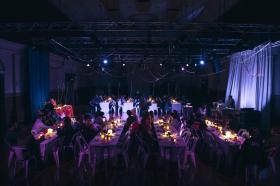Photo by Verne Ho on Unsplash.
The first thing Executive Director Veronica Pardo did when she arrived at Arts Access Victoria was get rid of time sheets.
Pardo realised trying to keep tabs on when her workers were in the office did not reflect the reality of the way they were working.
‘I think there is absolutely no point in keeping a record of people’s time at work because people are working in lots of different ways. They might be working at home, or they might be going to an event and doing important relationship building,’ said Pardo.
Work-life balance has become a kind of shorthand for leaving the office in time to pick up your child from care or working from home a day a week. The phrase implies an attitude to work that seesaws between ‘work’ and ‘life’ , as if work were not part of life.
But an evolving work culture is challenging this mindset with the idea that work can be integrated into other aspects of life. This change is particularly strong in the arts sector where the place we work and what we do for leisure frequently overlaps.
Integration encourages workers to take a nap during the day if they need it and equally expects that if they see a useful contact in the foyer after hours, they will work the opportunity. It doesn’t count hours or care whether you work in a cafe or in your pyjamas.
While the clear trend to flexible hours and the ability to work from home may be part of the picture, they are not the essence of integration. Rather it’s about challenging the attitudes that compartmentalise work and life.
It isn’t that people want to work less, although that is sometimes the case, they just want to work more flexibly.
Read: Helping men get work-life balance can help everyone
Not only does this change reflect a real need for more flexibility, but it also benefits organisations. Lower staff turnover, accessing a wider pool of talent, and establishing a workplace culture on trust are some of the outcomes work-life integration can achieve.
‘Whether it’s women, people with disabilities, or culturally diverse people, it’s about recognising that they will bring something that is highly valued to an organisation and in order to maximise their contribution we have to do things differently,’ said Pardo.
‘And isn’t that what’s essentially at the heart of an organisation, that capacity to capitalise on difference?’
To understand how arts organisations are encouraging work-life integration, we spoke with Writers Victoria and Arts Access Victoria to see what strategies they have adopted.
Kids, writing and the nap couch
At Writers Victoria staff can adjust their work schedule when they need to make personal appointments during the day and part-time employees are allowed to shift their days around to meet other commitments.
‘At a very base level we have an idea of ish. So someone might work 9-5, but it’s nine-ish to five-ish and we just trust that they’re doing their work. We are not over their shoulder ensuring that they get to work on time. So if you had something to do in the morning, you would come in at nine-ish and leave later that day,’ explained General Manager Jacquelin Low .
The organisation has a relaxed approach helpful for working parents. During the school holidays staff members can bring their children to the office and can take time off for parent-teacher interviews or to attend important milestones in the children’s lives, such as the first day of school – and not feel guilty about it.
As many people who work at arts organisations have their own side projects or creative practice they often need flexible arrangements so they can spend more time creatively engaged. This is true for Writers Victoria, where many of the staff members are writers themselves. To help writers meet deadlines, learn new skills, and to allow them time for their writing projects, the organisation supports writing activities as professional development and even has “writing leave”.
‘We had a staff member who was accepted into the hard copy manuscript conference so we paid for the flight and the time there as if it was work time. And if she had deadlines around her book then we offer her flexible writing leave as well,’ said Low.
‘If staff are taking time off to do writing, or are engaging in the industry, then we also know that they are fulfilling that other part of themselves which is going to make them happier at work.’
Read: Personal time promotes organisational creativity
Perhaps most creatively, Writers Victoria also allows workers to sleep on the job.
‘A few years ago we invested in the ‘nap couch’ which is in a separate little office. So if you are feeling sick or just need a time out, you can go on the nap couch and have a sleep. It can be a five minute snooze or two hours – no one disturbs you. We even have an eye mask,’ said Low.
Not only are naps allowed, but a weekly yoga session is also available for staff as part of a mental health plan that was implemented across the Wheeler Centre.
‘Every single one of us has said this is the best work place we have ever had. We have staff away days too where we go and talk about career development, what we want to achieve in our own lives, and what we want to achieve with work, so there’s a real sense of open communication between all the staff. There’s no negativity.’
Creating the right conditions
The critical thing to integrating work and life is building a culture that doesn’t see working from home or unconventional hours as slacking off. Integration enables everyone to participate and keeps employees engaged with the organisation which in turn allows both parties to progress the things that are important to them.
Arts Access Victoria deliberately chose a part-time work force, including Executive Director Veronica Pardo.
‘I think it is really important that I set that example in the organisation because it demonstrates that what is valued is the contribution you make and how you make it, not some artificial notion of who is in first, who stays latest. That kind of way measuring people’s commitment to organisations I think is really antiquated and outdated.’
‘I can tell you I absolutely believe that productivity is not tied to how many hours of work people are doing. I’ve seen organisations where people are in at 7:30 and they don’t leave until 7:30 at night and they are incredibly unproductive and a lot of the staff are disengaged from the work.’
To create flexibility at Arts Access Victoria the organisation has re-examined team work. Instead of allocating roles to one person, the organisation takes a team approach on how it will deliver particular outcomes.
Pardo also encourages staff to work from home if they can’t come into the office.
‘For example, if it is a particularly rainy day and a staff member uses a wheelchair they are fully set up at home with access to our network so they can work from multiple locations and don’t necessarily need to feel confined by the fact that they can’t come into the workplace.’
‘We have a really high percentage of people with disabilities in our workforce, and also people who identify as having an experience of mental health issues, and we have many people who have families. For all those reasons, retaining that skill and expertise means that we have to be flexible,’ said Pardo.
‘If you apply a universal access lens to it, and that’s to say “how do we create conditions in which everyone can fully participate without barriers”, workplace flexibility is one of those.’
‘Organisations who are resistant to this kind of flexibility are often captive of traditional approaches and are locating the responsibility for their failure to achieve strategic goals on things like external factors like funding or relationships. But what they are not looking at is the internal culture,’ concluded Pardo.





